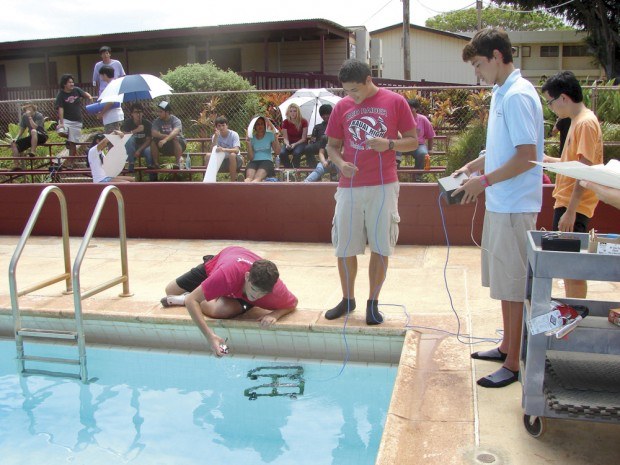LIHU‘E — Scientists and engineers of tomorrow have to get started somewhere. Don’t be surprised if a few Kaua‘i High School students are inspired by participating in the school’s underwater robots project. What makes the Marine Science Department ROV Competition
LIHU‘E — Scientists and engineers of tomorrow have to get started somewhere. Don’t be surprised if a few Kaua‘i High School students are inspired by participating in the school’s underwater robots project.
What makes the Marine Science Department ROV Competition special is that it’s not just for enthusiasts of remote operated vehicles. All students taking classes in the Marine Science Department participate in the project in a group effort that teaches applied science, teamwork and perseverance.
The event is held annually with students of Paul Crowe’s classes. The students design and build the ROVs for a two-day competition that was held Monday and Tuesday in the school swimming pool.
“The students did an excellent job,” Crowe said. “When something happened, whether a propeller fell off or somebody had to rewire a box, they didn’t get frustrated and give up. They fixed it up on the spot and were able to compete.”
The ROV frame is made of pvc pipe and has up to three electric motors that move it up and down and back and forth. A driver operates the rig with switches and 20 feet of ethernet cable hooked to a 12-volt battery.
Each team has a captain and a driver, but everyone has a part in the project. There is also electrical work that includes soldering, wiring switches, and building a control box.
The remaining members are on the building team, frame assembly, painting, building motors, wiring, waterproofing and mounting. Those that don’t feel so mechanically inclined complete the project documentation, produce a Powerpoint presentation, and make a poster for the competition.
The awards handed out Tuesday included the Winning ROV, Engineering Inspiration Award, Best Presentation, and Best Logo.
The object of the competition is to maneuver the ROV to pick up crabs on the pool floor. The crabs are actually pvc caps with stainless steel screws for eyes and wire cleaners for legs.
The ROVs use neodymium magnets and nets to grab or scoop the crabs. When they retrieve one to the pool side on the surface, it counts as a point.
Team HiHi managed to pick up one crab after suffering a broken propeller that made maneuvering the ROV a challenge.
The team included Reyn Morioka, driver, Nate Jacobsmeyer, electrical, Ryan Valenciano, Landon Negrillo, and Tyler Matsunaga.
“The biggest challenge by far was design and work ethic,” said Negrillo. “It was a team effort just to figure out what we were going to do at first.”
The record last year was six crabs. When Team USSR (Underwater Sea Scooper Robot) picked up 11 crabs, it looked like the competition was over.
The team included Kim Charles, frame, Kieran Caberto, motors, and Derek Fisher, electrical engineering and driver.
“Our team worked really well together,” said Fisher. “We learned about teamwork and how to solder, and we learned that even when everything is going great, you are going to run into problems and it’s up to the group to solve them together.”
Caberto said the strength of the design was to have the net below the magnet to catch the crab should it break free of the magnet on the way up.
Team KNG (Kyle and the Girls) picked up two crabs after experiencing and recovering from a major electrical failure.
The team included Kyle Napoleon, engineer, Ashley Schnackenberg, Jordan Zeffiro, Pua Dizol, Kiersten Yadao, and Alexis Hernandez.
Team Smooth (Submarine Operation Oceanic Tech Hawai‘i) outperformed everyone with 16 crabs. They had number 17 on the magnet and were just a few feet away from the surface when time ran out.
The team included Sam Lang Jr., engineer, Blaise Ferguson, driver, Justus Beiber, engineer, Travis Navarro, Bradley Beeksma, and Austin Oshiro.
“We learned that when everyone comes together they can find a solution,” Lang said. “It works when everyone contributes something.”
Crowe said the Team Smooth ROV was well built and credited the angle of the magnet for picking up so many crabs.
Crowe said the Kaua‘i High School Foundation made it possible by purchasing the materials. The administration and the groundskeepers made the pool available.
The goal of this project is to inspire people into the science and marine science fields, said Crowe. The competition is a way to apply their studies in a fun and innovative way that showcases individual and group talent.
“The United States is falling behind the world in producing engineers and scientists,” Crowe said. “It would be nice to see some of these students become the engineers, scientists and astronauts of tomorrow.”
Find out more at http://kauaihighschoolfoundation.com/rov.htm and kauaihighschoolfoundation.com.
• Tom LaVenture, staff writer, can be reached at 245-3681 (ext. 224) or by emailing tlaventure@thegardenisland.com.


